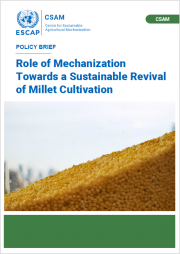Role of Mechanization Towards a Sustainable Revival of Millet Cultivation
Realization of agricultural production goals while compromising environmental issues is a common concern that reverberates across the globe. Fragile agricultural eco-system of Asia-Pacific region in terms of its susceptibility to climate change imperatives can be checked by widespread adoption of millet cultivation. This will not only nurture the owners of small and fragmented land holdings having high dependence on rainfed agriculture but will also suit the low investment capacity of the farmers and the ecological limitations of this region. Millet cultivation will deplete the overall contribution of agriculture to climate change and shall provide solutions to tackle the nutritional challenges of the vulnerable population groups.
There are numerous markers to indicate an overall dearth of agricultural mechanization in the Asia-Pacific region. Pre and post-harvest operations associated with millet cultivation lack the machinery-based solutions in terms of technology, machinery, trained personnel and protocols for processing operations, grain handling and storage.
This policy paper attempts to justify adoption of millets in the Asia-Pacific region and reports the trend in production and extant of spread of millet agriculture across the region. In particular, it introduces the readers to a road map for the promotion of millets to plug the gaps and counter the constraints so that a sustainable comprehensive pre and post production mechanization of millet agriculture can be realised. The paper highlights about the availability of equipment and machinery for tillage, sowing and harvesting; also brings to the fore a complete value chain for post-harvest processing of millets along with the primary and secondary operations leading to the generation of value added products.
The recommendations of this policy paper bench upon the actions required right from the approaches for sustainable mechanization in line with that available for major cereal crops along with the associated government support. It also delves upon the total value chain of the millets to make value addition viable and marketable. All the recommendations are in sync with the millet producing countries of the Asia-Pacific region for adoptable farm mechanization and post-harvest solutions towards an uninterrupted acceptance of millet in the agrarian eco-system of this region.

